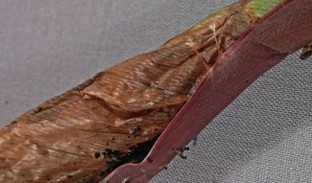Disease Notes
Contact
Plant Diagnostician
Phone: (479) 575-2727
Email: ssmith@uada.edu
Jason Pavel
Diagnostician
Phone: (479) 575-7257
Email: jpavel@uada.edu
University of Arkansas System Division of Agriculture
Cralley Warren Building
Room 16
2601 N. Young Ave.
Fayetteville, AR 72704
Canna – Lesser Leaf Roller
by Sherrie Smith and Jason Pavel

Canna Lesser Leaf Roller Larva – Geshna cannalis
Photo by Sherrie Smith, University of Arkansas Cooperative Extension
Which species of canna leaf roller are present in Arkansas?
Two species of canna leaf roller are present in Arkansas, the Larger Canna Leaf Roller, Calpodes ethlius (Stoll) (Insecta: Lepidoptera: Hesperiidae), and the Lesser Canna Leaf Roller, Geshna cannalis (Quaintance) (Insecta: Lepidoptera: Pyralidae). The Plant Health Clinic receives more samples of Lesser Canna Leaf Roller than Greater.
Characteristics and Control of Canna Leaf Rollers
Canna leaf rollers, as their name implies, roll canna leaves, and keep them rolled using silk produced by larva (caterpillar). This is accomplished by attaching silk before the leaf unrolls (preferred by the lesser canna leaf roller) or by attaching silk to one edge of the leaf and pulling toward the other edge (usually the larger canna leaf roller). Once rolled, the leaf provides a protective area for the caterpillar to feed.

Canna Lesser Leaf Roller – Geshna cannalis
Photo by Sherrie Smith, University of Arkansas Cooperative Extension
The lesser canna leaf roller caterpillars generally feed on the surface of the leaf and do not chew completely through the leaf, but the larger leaf roller feeds through the leaf. Later when the leaf opens, the feeding damage appears as holes in the leaves and ragged leaf edges. Canna leaf rollers only feed on plants in the Genus Canna and close relatives, so other plants in the garden are not threatened. This also makes management a little easier because dead plant material can be cut to the ground in winter and disposed of which reduces the number of overwintering larvae and pupae.

Canna Larger Leaf Roller Damage – Calpodes ethlius
Photo by Sherrie Smith, University of Arkansas Cooperative Extension
Systemic insecticides such as Merit may be used. Alternatively, a product applied to the leaves containing Bacillus thuringiensis (BT) gives control without toxicity to organisms other than members of the Lepidoptera.
Take Aways
- Larva can be handpicked.
- Cut canna foliage to the ground in winter and remove the spent foliage from the garden.
- Begin insecticides at the first sign of damage, or if using a systemic apply before damage in plantings with a history of leafroller.
This work is supported by the Crop Protection and Pest Management Program [grant no. 2017-70006- 27279/project accession no. 1013890] from the USDA National Institute of Food and Agriculture.